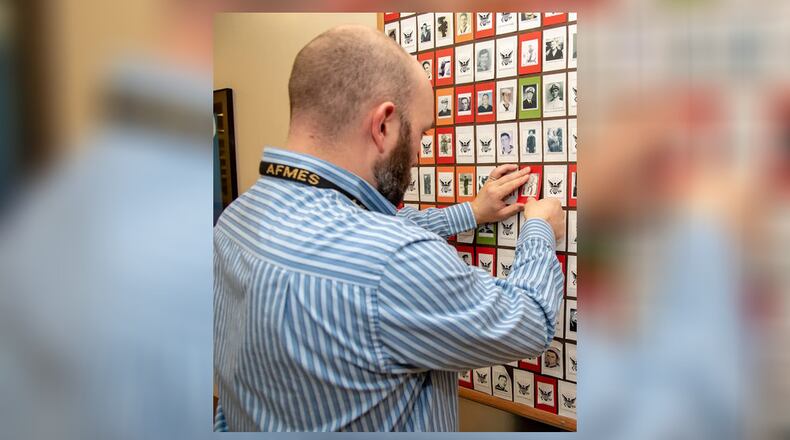The Defense POW/MIA Accounting Agency, based in Washington, provides the fullest possible accounting for missing personnel from past conflicts to their families and the nation. The agency searches for missing personnel from World War II, the Korean War, the Vietnam War, the Cold War, the Gulf Wars, and other recent conflicts.
Despite the improved technology, more than 81,700 Americans remain missing from WWII through the most recent conflicts. Out of those, 75% of the losses are located in the Indo-Pacific, and over 41,000 are presumed lost at sea, according to the agency.
For the fiscal year 2019, the agency identified 217 remains, a record. That was 14 more than 2018, 34 more than 2017 and 54 more than 2016, according to Army Sgt. 1st Class Sean Everette, a spokesman for the DPAA agency.
He said 120 remains were identified in 2020, but that number was greatly impacted by COVID-19 when investigation and recovery teams were pulled out of the field.
About 72,000 unidentified veterans are from World War II, followed by 7,667 from the Korean War, 1,589 from Vietnam, 126 from Cold War and six from recent wars.
In Ohio, more than 3,600 military personnel are missing, mostly from WWII. Ohio has 3,176 soldiers missing from WWII, 420 from Korea and 75 from Vietnam, including three from the area: Richard Stephenson (Hamilton), David Woods (Franklin) and John Conger II (Lebanon), according to the agency.
In the last two years, at least two area military personnel have been returned to their families for burial.
The remains of Navy Fireman 3rd Class Willard Irvin Lawson, 25, of Middletown, were identified in 2019 after they were buried in a mass grave.
Lawson’s niece, Linda Gordon, 72, of Milton, Ky., said she was thankful for him finally “coming home.”
Gordon said the family never knew where Lawson was buried and was told the sailors were buried in mass graves in three places.
Lawson was assigned to the battleship USS Oklahoma when it was attacked by Japanese aircraft on Dec. 7, 1941, as it was docked at Ford Island in Pearl Harbor. Lawson was one of 429 crewmen — 415 sailors and 14 Marines — killed in the attack.
He was buried April 27, 2019 in the Indiana Veterans Memorial Cemetery in Madison, Ind., seven miles from where his niece lives, she said.
From December 1941 to June 1944, Navy personnel recovered the remains of the deceased crew, which were subsequently interred in the Halawa and Nu’uanu cemeteries.
In September 1947, tasked with recovering and identifying fallen U.S. personnel in the Pacific Theater, members of the American Graves Registration Service (AGRS) disinterred the remains of U.S. casualties from the two cemeteries and transferred them to the Central Identification Laboratory at Schofield Barracks.
The AGRS subsequently buried the unidentified remains in 46 plots at the National Memorial Cemetery of the Pacific (NMCP), known as the Punchbowl, in Honolulu. In October 1949, a military board classified those who could not be identified as non-recoverable, including Lawson.
In April 2015, the Deputy Secretary of Defense issued a policy memorandum directing the disinterment of unknowns associated with the USS Oklahoma, according to the DPAA.
On June 15, 2015, DPAA personnel began exhuming the remains for analysis. DPAA scientists used dental and anthropological analysis to identify Lawson’s remains. Scientists from the Armed Forces Medical Examiner System assisted in using mitochondrial DNA analysis.
“When we are working on a loss, we work in the blind, which is to say we don’t have any information about that person in order to avoid biasing our analyses,” said Dr. Carrie Brown, who leads the DPAA USS Oklahoma project. “But once a loss has been identified, we are able to access that information, including photographs of the service member.”
The remains of 200 previously unknown crewmen from the USS Oklahoma have now been returned to their families for proper burial and their families have those long-awaited answers.
And last week, after nearly 80 years, U.S. Navy Radioman 3rd Class Thomas E. Griffith, of Dayton, was laid to rest at Arlington National Cemetery. Griffith, 20, was killed during World War II when he was assigned to the USS Oklahoma.
By April 2020, mitochondrial DNA analysis played a key role in the identification of Griffith’s remains, the agency said. The mitochondria and mitochondrial DNA are passed from mother to child.
Everette said Griffith family members contributed DNA family reference samples to the Navy to assist in the task of identification.
“They’re all pretty amazing,” he said of the work that leads to resolutions in these matters.
Credit: Nick Graham
Credit: Nick Graham
Staff writer Thomas Gnau contributed to this report.
About the Author


